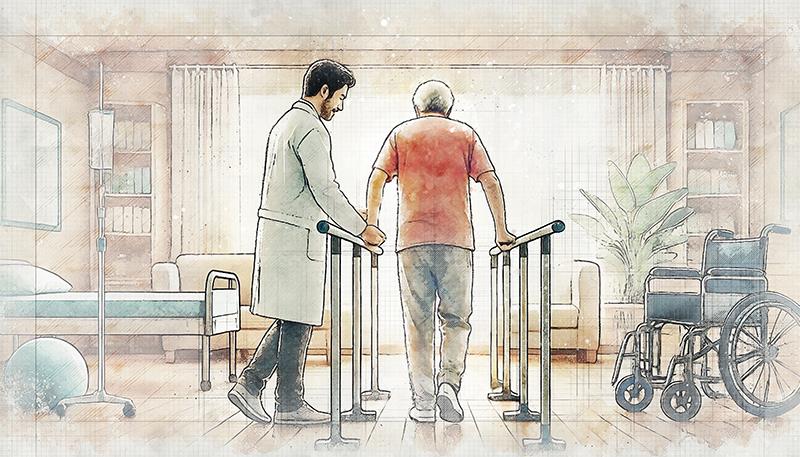Progressively higher-intensity walking plus PT enhances stroke recovery





Augmenting standard physical therapy (PT) with a progressively higher-intensity walking exercise programme in inpatient stroke rehabilitation units improved mobility and quality of life (QoL) in stroke survivors, a study has shown.
Using a stepped-wedge cluster design, the investigators conducted the study at 12 stroke units across seven provinces in Canada. Participants were 306 patients (mean age 68 years) admitted to the stroke rehab unit about a month since having a stroke. They were instructed to undergo standard PT alone (n=162) or with the Walk ‘n Watch protocol (n=144). The baseline 6-minute walk test (6MWT) was 152 m.
The Walk ‘n Watch protocol was implemented during PT sessions (usually 4 weeks), with the goal of completing 30 min of daily weight-bearing and walking-related activities that increased in intensity over time during inpatient rehab. Starting step goals differed depending on 6MWT. For instance, at moderate intensity (100–200 m 6MWT), the goals at weeks 1 and 3 were 2,000 and 3,000 steps, respectively. Heart rate and steps were tracked using wrist and ankle monitors.
At 4 weeks post-admission, the improvement on the 6MWT was 43.6 m greater in the Walk ‘n Watch vs standard PT arm. [ISC 2025, abstract 22]
“[T]he minimal clinically important difference (MCID) in literature ranges anywhere from about 30 to 60 m, so our values are within the MCID for an important difference,” said Professor Janice Eng from the University of British Columbia in Vancouver, Canada, at ISC 2025.
There were also significant differences favouring the Walk ‘n Watch protocol in terms of QoL measures (EQ5D Visual Analogue Scale, 8), balance and mobility (Short Physical Performance Battery, 1.15), and gait speed (0.134 m/s). Eng noted that in terms of magnitude, the values from these parameters also fall within the clinically significant realm.
“The major advance for this study was that we trained all frontline therapists [across all] stroke units. [They] completed the safety screening and ensured participants’ eligibility for the protocol,” said Eng. “We wanted to see what would happen if we moved this protocol into standard practice so all therapists and participants could follow … The protocol was successful despite the trial being pragmatic and operated in a real-world setting.”
Practice-changing
The trial showed that the Walk ‘n Watch protocol has the potential to change the practice of entire rehab units and sustain it over time.
“It is very difficult to change practice, [but the researchers showed] that it can be done in the inpatient rehab unit at a critical period after stroke when the brain is most plastic,” commented Dr Preeti Raghavan from the Johns Hopkins Department of Physical Medicine and Rehabilitation, Baltimore, Maryland, US, who was not involved in the study.
“The protocol increased endurance and further reduced disability after stroke. This is very positive data for stroke recovery,” Raghavan added.
Early recovery crucial for neuroplasticity
Eng noted that high repetitions of walking during subacute stroke improves walking recovery and QoL. Guidelines recommend that stroke survivors who can participate in 3 hours of therapy 5 days a week and who are medically stable should receive care from an inpatient rehab facility. [Stroke 2016;47:e98-e169]
“Although guidelines recommend structured, progressive exercise after stroke, the uptake of these approaches that have sufficient intensity for rehab programmes is still lagging,” said Eng. “Structured and progressively more challenging exercise, aided by wearable devices to provide feedback on intensity, can help people maintain safe intensity levels that are crucial for neuroplasticity – which is the brain’s ability to heal and adapt.”
“The first couple of months after a stroke are when the brain has the greatest ability to change. Our study shows positive results during the initial rehab stage,” Eng continued.